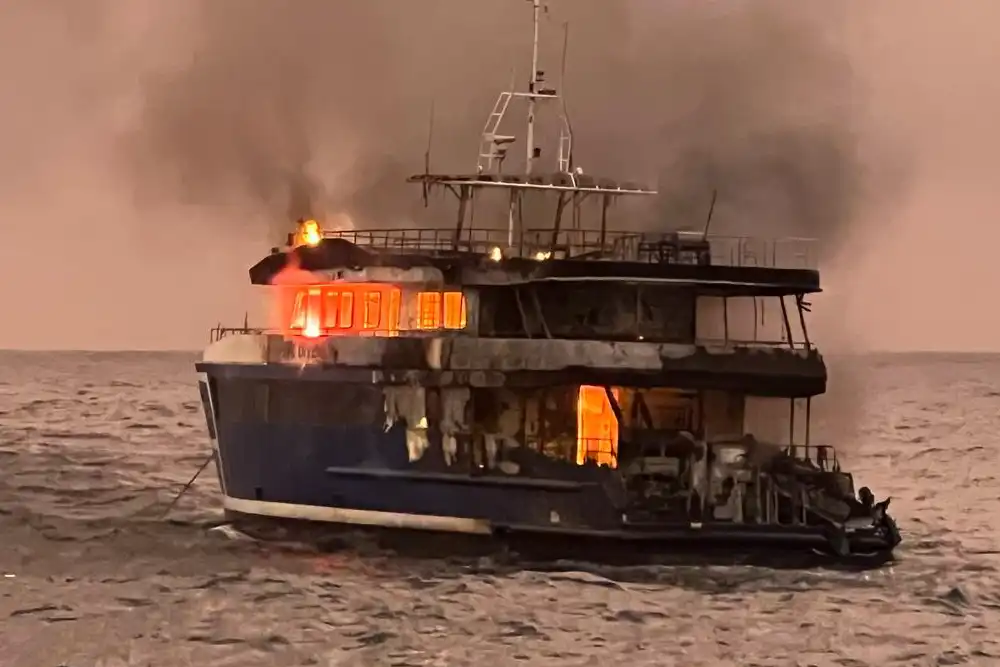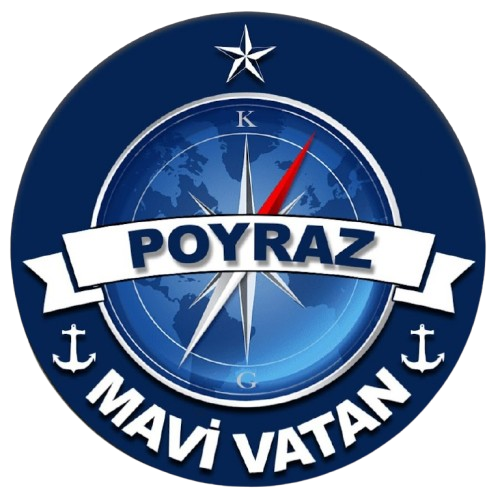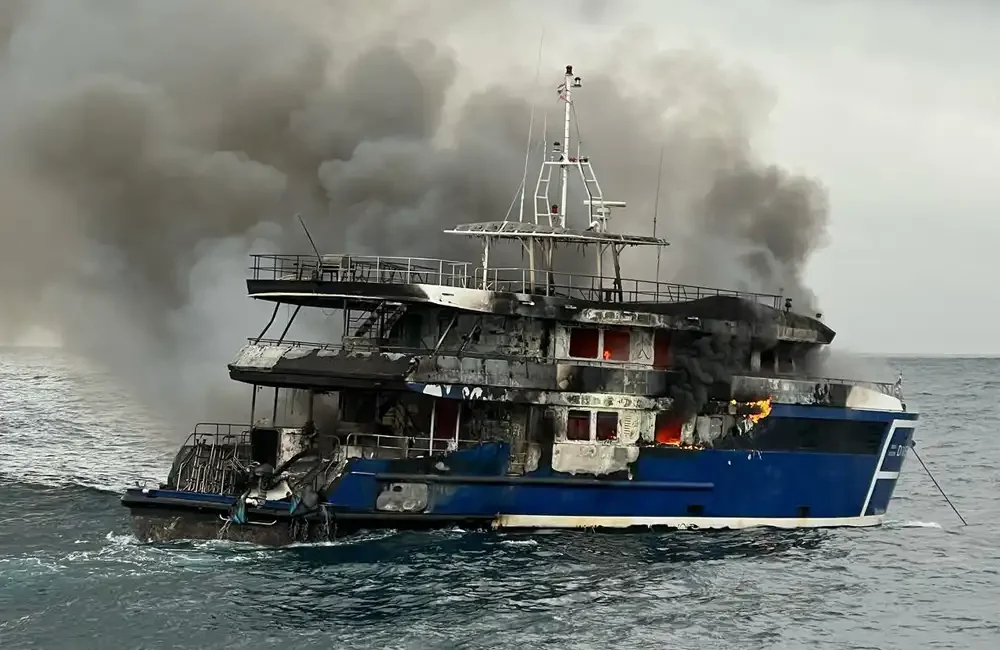The second part of our interviews with survivors of the Thai liveaboard DiveRACE Class E Fire, which burned to the waterline in the Similan Islands in April 2025.
By Mark ‘Crowley’ Russell
This article was split in two due to its length. Part 1 is here.
Alexandre Guedes, CEO of a Portuguese pharmaceutical company and an experienced diver, was on board DiveRACE Class E the night it caught fire, together with his wife, teenage son Filipe and daughter Mia.
‘We are relatively well physically and psychologically,’ he tells me when we speak, ‘and Filipe and Mia are also slowly getting over the situation, which hasn’t been easy.’
Alexandre, who had previously worked as an airline copilot, was fastidious about liveaboard safety, even if the boats themselves were not.
‘This was our third liveaboard,’ he said, ‘and we have always briefed our children on what to do in the event of a fire – and agreed with them that in a situation like this they would not wait for their parents and would flee to the furthest place from danger, which would eventually be our meeting point.

Fortunately, they did not become separated, but the lack of alarm meant they remained belowdecks longer than some of the other passengers, who had already made their way outside.
‘We were asleep when we heard someone shouting that there was a fire on board,’ says Alex. ‘There was no light and we couldn’t breathe, so the only thing I could do was leave the room with my wife and my mobile phone, because we needed a light.
‘We chose the light over everything else; equipment, computers, passports, money, everything, and we stayed to put on our life jackets before leaving the room.
‘The problem was the smoke, because when my children left the room we told them to put a towel [soaked] with water over their mouth, but after five metres we couldn’t breathe, and it was a very, very difficult situation.
Alex and his family were able to make their way outside, where he took his daughter and jumped into the water, followed by his wife and son. Raga was already nearby and they were picked up by one of the tenders before being taken to the liveaboard.
As with the other survivors, Alex is gravely concerned about the lack of response from the crew, the lack of a fire alarm system and the failure to post a night watchman.
‘Only when we were upstairs on the boat about to jump, only then did we see the crew,’ he said. ‘We did all of this by ourselves, and there was no alarm.
‘The only alarm we had was the Israeli guy [the passenger who also woke Nicole and Joe] who was shouting for everyone.’
‘The problem is that the guys from the crew were all sleeping. If anybody was awake then the problem would have been minimised.’
Importance of the night watch
There is much discussion on the internet on whether or not a night watch is necessary while at anchor but the simple answer is yes, if you’re at sea.
A resolution adopted in 1973 by the United Nation’s International Maritime Organisation (IMO; at that time International Maritime Consultation Organisation, IMCO) clearly states that the ship’s master, while at anchor will ‘ensure that an efficient look-out is maintained’ and ‘ensure that inspection rounds of the vessel are made periodically.’
The lack of a roving night watch was directly blamed for the deaths of 34 people in the Conception disaster of 2019 off the coast of California. A National Transportation Safety Board (NTSB) investigation into the cause states that:
The probable cause of the accident on board the SPV CONCEPTION was the failure of [the boat’s owner] to provide effective oversight of its vessel and crewmember operations, including requirements to ensure that a roving patrol was maintained, which allowed a fire of unknown cause to grow, undetected, in the vicinity of the aft salon on the main deck.
In the end, there’s little argument to be made against the practicality of posting a roving night watch on vessels that contain highly flammable materials, are filled with combustible fluids and potentially volatile electronic equipment, with people on board, miles out to sea, with very little assistance nearby.
In 2019, 34 people died because by the time anybody realised their boat was on fire, it was already too late. The passengers and crew of Class E all survived, but if that one sleepless diver had not been awake to notice, the outcome may have been very tragically different.
The US Coast Guard has since been issued orders to enforce inspection procedures, verifying that proper roving patrols are conducted.
The unforgivable lack of fire detection equipment
Thai authorities reported that the blaze began in one of the generators used to power facilities on board the boat such as the lights and hot water heaters, and the passengers we’ve spoken to said that there had been problems with hot water for the previous few days owing to a generator malfunction.
A faulty generator at the end of a busy dive season (the Similans National Park closes on 15 May each year) would not be considered out of the ordinary, but according to the vessel’s specifications, it was fitted with two 90 KW Cummins generators.
Some of the passengers believe one of the generators had already failed, and the second was therefore overworked. While this has not been possible to verify, the total lack of power when the fire broke out would indicate that neither was operational.
Either way, the faulty generator represents the first hole in the ‘Swiss-cheese model of safety’. While the name sounds slightly trite, it is a well-known analogy in which each layer of protection against accidents is represented as a slice of Swiss cheese, each with a hole representing a weakness in part of the system.
One or more can fail without serious consequence, but once all the holes are aligned, catastrophic failure becomes inevitable.
The next hole in the safety model, and one of the most neglectful on behalf of the operator, is the lack of any kind of functioning smoke detectors and fire alarm system, which should be mandatory for all vessels on which passengers will be staying overnight.
‘Fire is most likely to occur in the engine room,’ said Chanhyeok ‘Chris’ Kim, who is head of the fire team on board 200,000MT merchant ship on which he is a chief officer, ‘and there should be extinguishing equipment or an alert system for smoke detection. But there was nothing.’
It is a stroke of luck that a sleepless passenger happened to be on deck and noticed the smoke. Had he not been there, the outcome could have been far, far worse.
Inadequate firefighting measures

Once the fire broke out, there did not appear to be an adequate supply of firefighting equipment on board, another hole in the safety model.
The boat’s specifications list 15 fire extinguishers throughout the decks but the lack of muster drill meant passengers hadn’t been shown where they were located and survivor Nicole Yeates – who works for the US Department of the Navy – believes those that were on board were not sufficient to combat a serious fire.
She recalls seeing a member of the crew ‘running around with a fire extinguisher that was about a foot and a half tall.’Alexandre also remembers seeing ‘only one little fire extinguisher’ on the main deck.
‘The flash point of marine diesel is very high,’ said Nicole, ‘but the temperature of the fire is hot enough to burn through anything.
‘By the smell of the smoke we encountered, which was very acrid, the fire was already burning through lube oils and plastics, and that was our first indication there was a problem
‘By that point,’ she added, ‘the fire was already beyond a hand extinguisher.’
Lack of crew preparedness
Both Nicole and Alexandre describe the crew as good people and very competent in the context of running the liveaboard but, apart from the Captain, unprepared to handle an emergency.
Nicole praised the crew’s willingness to help, but said they seemed ‘a little bit frozen.’
‘They just weren’t trained,’ she said. ‘They definitely wanted to help and the captain was very well prepared, he was helping here and there and he was indeed the last one off the ship.
‘He’s a good man, for sure, and when we were at the police station afterwards, he was walking around to all his crew, checking on them. A good man.’
It has been a common story told by survivors of liveaboard disasters, including those of Sea Story, Hurricane, Sea Legend and even Conception – that the boats’ crews were great at everything else, but not well prepared to deal with emergencies.
It is difficult to place the blame for that on any individual crew member – it’s impossible to know how even an experienced person will react in an emergency – but the lack of preparedness among the crew as a team suggests a lack of emergency training.
It fell to passengers and foreign dive staff to prepare the life rafts on Class E, attempt to signal the nearby boat and even rescue the two passengers who had been unable to make their way out of the lower deck.
All the holes aligned
A faulty, possibly overloaded generator; no fire detectors or alarm; insufficient fire suppression systems; untrained crew; no battery backup or emergency VHF radio; no muster drill – the holes in the Swiss cheese model of safety were all aligned.
The Thai Navy didn’t arrive for several hours, and when they did, it was a small patrol boat with an onboard fire hose. The liveaboard burned for seven hours before the firefighting unit arrived on the scene and was able to extinguish the fire, but by then it was too late.

Diverace Class E burned to the waterline, along with all of its passengers’ dive gear, clothing, passports and possessions, before sinking into the depths.
The story has not made international headlines in the same way that Sea Story and Conception did, because nobody died. Had another liveaboard, the MV Raga, not been nearby, however, the story would almost certainly have been tragically different, as passengers would have had to fight rough seas, strong currents, and a night lit only by the fire from their burning boat while they waited to be rescued.
Speaking with Nicole and Alexandre, it is clear that although they escaped with their lives, the trauma of that night has left a lasting impact on them and their families.
We made contact with the Singapore-based owner of Class E, who was genuinely apologetic over the incident. While he was unable to provide any details due to the ongoing investigation into the fire, he issued the following statement:
We have been operating MV DiveRACE Class E since her launch in 2015. She was designed and constructed following Thailand’s marine regulations. The vessel is also inspected every year by the marine authorities to ensure safety and sea worthiness before renewing its licence.
Items such as independent back up batteries, radios and fire extinguishers were available. Procedures such as evacuation and man over board were briefed during the onboarding process.
As investigations are still ongoing, we are unable to give more information until everything is completed please. However, we are working hard with our insurer to finalise the compensation to all affected guests.
DiveRACE will also review and implement additional training for all procedures that will be applied to our new vessel to ensure such an incident will not happen again.
Having spoken directly with the owner, I believe he is sincere in his intention to implement tougher safety measures on board his company’s second boat, which is currently under construction.
The problem, of course, is that these safety features were not present, or not properly implemented on the boat that caught fire, something that has been increasingly recognised as a problem across the liveaboard dive industry
What next for liveaboard safety?
When Jerry Boylan, captain of Conception, was prosecuted for Seaman’s Manslaughter, his defence team tried to mitigate his sentence on the basis that every other boat in the area was guilty of the same lackadaisical approach to safety, and he shouldn’t be blamed for the failings of an entire industry.
One of his crew wrote that his negligence that night ‘was trusting that what had been safe and successful for 30 years all of a sudden wasn’t.’
It appears this attitude is prevalent among many dive operators: there are lots of liveaboards; there are hundreds of thousands of sailings, most of them are just fine, and with so many boats, accidents are bound to happen.
As Alexandre puts it, however, ‘the entire sector needs to undergo a basic reform in terms of safety,’ because if it doesn’t, more people are going to die, and there have already been too many liveaboard deaths.
Until that reform happens, it falls once again to us, as divers, to call out the operators where we see problems, and demand better of them before we board their boats.
DiveRACE Class E is an excellent example of a fine liveaboard chosen by discerning divers for its good reputation, highly-praised crew and excellent safety record, because for the previous ten years, everything had been safe and successful.
And then all of a sudden, it wasn’t, because without a proper fire alarm system, that boat was not fit to set sail.
This story, for reasons of length, appears in two parts. The first part is available here.
The post Survivors of Thai liveaboard DiveRACE Class E fire speak out – part 2 appeared first on DIVE Magazine.







